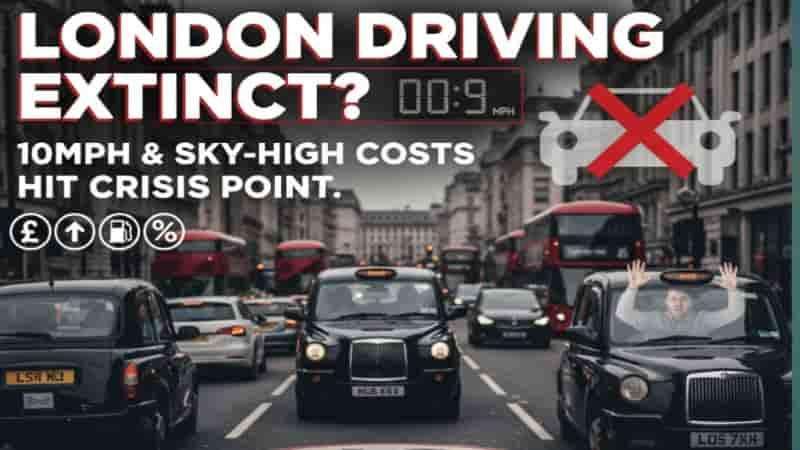Chaos on the Cobbles: Temporary 10mph Limit Fuels Anti-Driver Fury-London is facing a deepening crisis over vehicle use as a new temporary 10mph speed limit in a central borough ignites fierce criticism from drivers, who already contend with some of the highest driving costs and most restrictive road measures in the world. The trial restriction, implemented by Islington Council on a congested St John's Street near Smithfield Market, is part of a six-month order to narrow lanes for the installation of a traffic filter, trees, planters, and rain gardens intended to enhance safety and aesthetics, Daily Dazzling Dawn realized.
The restriction has been dismissed as the "peak of insanity" and an "anti-driver crusade" by campaigners, with reports of even cyclists exceeding the new limit. FairFuelUK founder Howard Cox, a vocal critic of previous 20mph limits due to concerns over increased emissions at persistent low gear and dubious accident reduction proof, labelled the 10mph maximum an act of "complete stupidity" from road transport planners. He questioned the feasibility of policing such a low speed, noting that no vehicle, even a bicycle, is likely to adhere to it, and doubted the accuracy of existing camera technology for measuring infringements at that level, suggesting anti-driver policies by local authorities had reached a "new height of insanity."
On the ground, these sentiments are widely echoed. Harry, a 33-year-old black cab driver from Greenwich, expressed that ubiquitous 20mph limits are already a "hindrance" to his livelihood and dangerous, forcing drivers to focus on the speedometer instead of their surroundings. He highlighted the potential severity of enforcement, warning that two violations over 25mph could lead to six penalty points and vehicle suspension by Transport for London (TfL). Lorry driver Jason Fenton, 64, from Hertfordshire, observed cyclists openly flouting the new cap while unloading furniture, calling the restriction "pointless" and "too restrictive." Fenton suggested the council appears intent on encouraging foot or bicycle travel, despite the commercial reality that local offices rely on daily lorry deliveries, arguing that council restrictions are making commerce "very difficult."
Conversely, some drivers see the logic. Dennis Puscas, a 34-year-old white-van operator, supported the rationale, stating, "It's a safety issue. Reducing the speed from 30mph to 20mph in central London has had a good impact, right? I believe they've got the same reason here—to make it safer for everyone."
Councillor Rowena Champion, the executive member for environment, air quality and transport, defended the measures as a direct result of public consultation, noting that local people requested a greener, more accessible, and pleasant environment. She confirmed the 10mph limit was a temporary safety measure necessitated by the carriageway narrowing during the construction work on St John's Street and committed to working with residents and businesses to minimise disruption.
The Financial Weight Crushing London Drivers-The introduction of increasingly tight speed controls is just the latest hurdle for London motorists, who are burdened by a staggering combination of fees, narrow roads, and sky-high insurance costs. London remains the most expensive region in the UK for car insurance, with average annual premiums often exceeding £850, well above the national average, although recent market data has indicated a general softening in national and city-specific prices.
Compounding this financial strain are the complex and punishing road user charges that operate across Greater London. The most significant costs include the Ultra Low Emission Zone (ULEZ) charge of £12.50 per day for non-compliant vehicles, which operates 24 hours a day across all London boroughs. The Congestion Charge (CC), currently set at £15 daily for most vehicles entering central London during charging hours, is proposed to increase to £18 from January 2026. Furthermore, drivers of heavier, more polluting vehicles must also contend with the Low Emission Zone (LEZ) charge, which applies across most of Greater London and can cost £100 per day for non-compliant lorries and coaches.
In addition to these daily charges, enforcement is rigorous, with offenders risking a \text{£100} fine and three penalty points for speeding or red-light violations. Last year alone, Islington Council generated over £20 million from 410,266 parking penalties.
The Wider Context of London's Road Network-These restrictions are part of a wider shift in transport policy across the capital. Private vehicle numbers have already dropped by 4.6\% since 2016, falling to 35,665 by 2020. Since 2020, seven Low Traffic Neighbourhoods (LTNs) have been introduced to block 'rat-runs,' although they have been met with mixed reviews due to increased journey times for some. The council also claims to have repaired all 1,896 potholes reported between April 2024 and March 2025, equating to more than 12 per road mile.
Meanwhile, national political debate continues to rage over the cost of driving. In the House of Commons this week, Conservative MP Lewis Cocking raised the issue of fuel duty, citing a FairFuelUK poll showing widespread cross-party support for keeping the tax frozen or reduced, a regressive tax that hits low-income families hardest. Exchequer Secretary Dan Tomlinson acknowledged that the current 5p cut to fuel duty is set to expire in March 2026, stating that a final decision would be made by the Chancellor at the Budget in the context of the public finances.
As London navigates roadworks, speed limits, and mounting financial charges, the capital’s commitment to a cleaner, safer, but more restricted road network places increasing pressure on drivers, raising the fundamental question of whether personal vehicles have a viable future in the city.


.jpg)




.svg)
